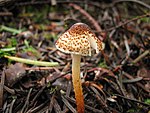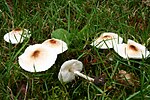Lepiota
| Lepiota | |
|---|---|

| |
| Lepiota clypeolaria, the type species | |
| Scientific classification | |
| Domain: | Eukaryota |
| Kingdom: | Fungi |
| Division: | Basidiomycota |
| Class: | Agaricomycetes |
| Order: | Agaricales |
| Family: | Agaricaceae |
| Genus: | Lepiota ( Pers.) Gray (1821)
|
| Type species | |
| Lepiota clypeolaria | |
| Synonyms | |
Lepiota is a
Taxonomy
History
Agaricus
Based on macro- and micromorphology, later authors gradually refined the generic concept of Lepiota. Some unrelated genera, such as
The
Current status
Following some discussion over the
The name "Lepiota" is derived from the Greek λεπις (= "scale") + οὖς (= "ear").[14]
Description
Fruit bodies of Lepiota species are almost all
Habitat and distribution
Most if not all Lepiota species are
Toxicity
Several species contain
Literature
No comprehensive monograph of the genus has yet been published. In Europe, however, species of Lepiota were illustrated and described in a regional guide by Candusso & Lanzoni (1990)[4] and more briefly in descriptive keys by Bon (1993).[15] Dutch species were illustrated and described by Vellinga (2001).[24] No equivalent modern guides have been published for North America, but Vellinga (2008) has published an online bibliography of the relevant literature.[25] In Australia, a guide to the Lepiota species of south-eastern Queensland was published by Aberdeen (1992).[6] In Asia, a study of Lepiota diversity in northern Thailand revealed 73 species.[26]
List of species
The following species have individual entries:
- Lepiota ananya
- Lepiota anupama
- Lepiota babruka
- Lepiota babruzalka
- Lepiota bengalensis
- Lepiota brunneoincarnata
- Lepiota castanea
- Lepiota clypeolaria
- Lepiota harithaka
- Lepiota helveola
- Lepiota ignivolvata
- Lepiota nirupama
- Lepiota shveta
- Lepiota spheniscispora
- Lepiota subincarnata (synonym L. josserandii)
- Lepiota zalkavritha
- Lepiota locanianisis † (extinct)
The following species have individual entries, but are now placed in different genera:
- Lepiota aspera = Echinoderma asperum
- Lepiota lutea = Leucocoprinus birnbaumii
- Lepiota molybdites = Chlorophyllum molybdites
- Lepiota naucina = Leucoagaricus leucothites
- Lepiota procera = Macrolepiota procera
- Lepiota rhacodes = Chlorophyllum rhacodes
See also
References
- ^ Persoon CH. (1797). Tentamen dispositionis methodicae Fungorum (in Latin). Leipzig, Germany: Wolf. p. 68.
- ^ Gray SF. (1821). A natural arrangement of British plants. Vol. 1. London: Baldwin, Cradock and Joy. p. 601. Retrieved 2011-08-05.
- ^ Fries EM. (1821). Systema Mycologicum. Vol. 1. Lund, Sweden: Ex Officina Berlingiana. p. 19. Retrieved 2011-08-05.
- ^ a b c Candusso M, Lanzoni G (1990). Fungi Europaei 4: Lepiota s.l.. Alassio, Italy: Edizioni Candusso. p. 743.
- ^ JSTOR 3761269.
- ^ ISBN 978-0-9596526-4-2.
- ^ Bon M. (1991). "Les genres Echinoderma (Locq. ex Bon) st. nov. et Rugosomyces Raithelhuber ss lato". Documents Mycologiques (in French). 21 (82): 61–66.
- ^ Castellano MA. (1995). "NATS truffle and truffle-like fungi 4: Amogaster viridigleba gen. et sp.nov., a new truffle-like fungus from the Sierra Nevada". Mycotaxon. 55: 185–8.
- ^ S2CID 18543761.
- ISSN 0078-2238.
- ^ International Code of Botanical Nomenclature (Vienna Code, 2006), Appendix III "INTERNATIONAL CODE OF BOTANICAL NOMENCLATURE online". Archived from the original on 2012-10-06. Retrieved 2011-02-20.
- S2CID 13944947.
- S2CID 42847042.
- ^ Rea C. (1922). British Basidiomycetaceae: a handbook of the larger British fungi. Cambridge, UK: Cambridge University Press. p. 799.
- ^ a b c d Bon M. (1993). Flore mycologique d'Europe 3: Les Lepiotes. Amiens Cedex: CRDP de Picardie. p. 153.
- ISBN 978-0-85199-826-8.
- ISBN 978-0-7167-2649-4.
- PMID 11715136.
- PMID 20870578.
- ^ Boiffard J. (1987). "Une intoxication familiale par Lepiota brunneolilacea". Documents Mycologiques. 69: 21–23.
- ^ PMID 2282295.
- .
- S2CID 28756785.
- ISBN 978-90-5410-494-0.
- ^ Vellinga EC. (2008). Bibliography of North American Lepiota species – v. 2.1 http://nature.berkeley.edu/brunslab/ev/americanlepiotaliterature_2.1.pdf
- S2CID 82743099.






